As the stellar bass fishing action of the spring months comes to an end, the transition between spring and summer can be a frustrating and, quite honestly, disheartening time for anglers. The bass are constantly moving, they’re hard to pinpoint and the unpredictable weather patterns don’t do us any favors, either.
Thankfully, however, lipless crankbaits serve as a major source of hope throughout this awkward time of year. These age-old lures may not look very fancy, but Elite Series pro Shaw Grigsby believes they’re a tremendous equalizer when you’re fighting the battle against stubborn summer bass.
Throughout his career, he has frequently relied on 5 lipless cranking hotspots that many anglers tend to overlook. Regardless of the fishery or the mood of the bass, these areas have bailed him out of some tough situations and even led to some monstrous 30-pound limits.
Before we discuss the particular locations, let’s quickly delve into a few important variables that will help you maximize your success with these lures.
- Depth control
- Size selection
- Primary colors
- Optimal locations
Depth control and versatility
As the name implies, lipless crankbaits lack the diving bills found on the front of traditional diving crankbaits. This important omission allows anglers to target both shallow and deep water by utilizing simple retrieve variations.
“Once the bass are done spawning, a lipless crankbait becomes a major player throughout the entire summer,†Grigsby said. “Bass become hugely focused on shad as they’re refueling and recovering from a rigorous spawning season and these lures are incredible shad imitators. More importantly, however, a lipless bait gives you the ability to control your depth easily without constantly switching lures.â€
While standard crankbaits can be productive this season, their diving bills can significantly limit an angler’s ability to cover multiple depth zones in a single cast. Because these crankbaits are designed to run at specific depths, efficiency can become an issue—especially when the bass are scattered throughout the water column.
“When bass are making their way from their spawning grounds, there’s a good chance you’ll find them in a variety of depth zones,†Grigsby said. “With a lipless crankbait, I can target shallow fish in just a few feet of water and motor down the bank and cast to ‘em in 15 or 20 feet of water. Depth control and versatility are huge factors this time of year.â€
In order to control the depth of his lipless crankbait, Grigsby relies on three particular retrieves.
- Slow your roll— Much like he’d slow-roll a spinnerbait in shallow water, Grigsby most often begins his lipless crankbait approach with a slow retrieve. He’ll include intermittent twitches and jerks to add realism to his presentation and attract reaction strikes from otherwise lethargic bass. Because these lures sink, the point at which he engages his reel is critical. In shallow water, he begins reeling right before his lure hits the water. Conversely, he often lets the lure fall for a few seconds before engaging his reel when targeting deeper depths.
- Yo-yo it— “I’ve caught some of my biggest fish yo-yoing a lipless crankbait off the bottom,†Grigsby said. “They absolutely cannot stand it. I’ll make a long cast, let it sink to the bottom on a controlled-slack line, tighten my line and pull or rip it towards the boat. I’m using the rod to move the lure—the reel is simply there to eat up my slack. As it falls back to the bottom, it’s important to follow your slack downward with your rod tip because most of your big bites come on the fall. If your rod is too high when that fish hits it on a slack line, you’ll be out of position for a solid hookset.â€
- Tick the cover— Although lipless crankbaits aren’t equipped with a bill to aid in deflection, their nose-down swimming action makes them surprisingly snag-resistant after a bit of practice. Anytime he’s targeting submerged vegetation or even hard cover, Grigsby makes an effort to quickly retrieve the lure while barely ticking it submerged cover. This can certainly be effective for big largemouth, but he’s also enjoyed consistent success while targeting smallmouth bass with this retrieve.
Simple size selection process
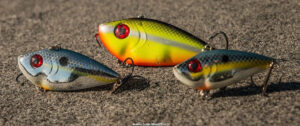
To a non-angler, buying fishing tackle may seem like a fairly simple endeavor. But to “fish heads†like us, it’s anything but easy. With endless models from which to choose, it can actually become a bit overwhelming. Can a bass really tell the difference between a 2-inch lure and a 2 1/4-inch lure? They’re not really that smart, are they?
A look inside of Grigsby’s lipless crankbait selection would likely surprise you. Although you’d expect to find endless shapes and sizes in a professional angler’s arsenal, his Strike King Red Eye Shad collection focuses on three particular sizes.
- 1/4-ounce— “A 1/4-ounce Red Eye Shad is our smallest size,†Grigsby said. “And while it’s not necessarily my first choice throughout the summer, I’ll certainly use it when I’m on a fishery that’s not necessarily known for its trophy quality. If I’m around a lot of small fish, I won’t hesitate to break it out and go to work. It’s important to realize, however, that it does have its place on big fish lakes. If I’m battling high barometric pressure and post-frontal conditions, I’ll downsize to a 1/4-ounce lipless and catch some really nice fish.â€
- 1/2-ounce— The annual shad spawn is always a major focus for pro anglers throughout the late-spring and early summer months. According to Grigsby, there’s no better size than a 1/2-ounce Red Eye Shad when targeting these potential jackpots. Additionally, he believes this size to be an excellent starting point for anglers new to the technique. If you’re having trouble deciding on a “perfect†size, it’s a happy medium in most situations.
- 3/4-ounce— “A 3/4-ounce lipless crankbait is absolutely my favorite size,†Grigsby said. “It’s exactly 3 inches long and it can catch some definite pigs. Most of the forage is fairly large and healthy in the warmer months, so this size is a great imitation as the water continues to warm. Don’t think, however, that you’re sacrifice quantity when throwing this larger model. While the big ones really fall for it, you’ll catch plenty of 2-pounders as well.â€
Color patterns that produce
Much like choosing lipless crankbait sizes, color selection can also seem a bit daunting at times. But to continue with Grigsby’s theory of simplicity, he believes these 4 color patterns to be most productive this time of year.
- Chrome Sexy Shad— “This is probably the color with which I’ll most often start,†Grigsby said. “Everyone needs a good shad pattern and I like this one because it looks very similar to both threadfin and gizzard shad. It has a bunch of flash and that added bit of chartreuse makes it equally effective in off-color water as well.â€
- Chartreuse— It might look a little strange at first glance, but Grigsby swears by a chartreuse lipless crankbait, especially when he thinks the bass are feeding heavily on panfish. It’s also a good choice when you’re fishing dirty water after the heavy rainstorms of summer.
- Red— “You gotta have a red one,†Grigsby said. “There’s just no way around it. Most lakes I visit in the late-spring and summer—especially ones with a lot of grass—are incredible places to use this color. It’s not just a Texas thing like many people think. As long as you have grass, you’ll catch ‘em on a red-colored lipless.â€
- Sexy Blueback Herring—“If you fish both blueback and threadfin lakes, this is a great color choice that will work great between the two,†Grigsby said. “While it was designed to look like a blueback herring, it can also serve as your number one shad color. This is another one of those great starting colors, so if you can’t decide what color to use, start with this one.â€
Hotspot No. 1: Depth changes adjacent to spawning flats
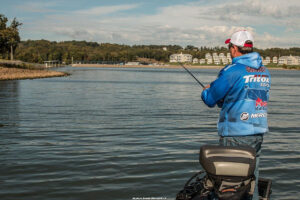
A bass’ natural post-spawn progression is almost identical to its prespawn journey—except in reverse order. When the big females conclude their spawning activities, they’ll use the first depth change adjacent to a spawning flat to both recover and feed.
Grigsby starts by locating a probable springtime spawning flat. He’ll then move towards open water and locate the first depth change.
“When I find these ‘first drops’, as I call them, I generally postition my boat in deeper water,†Grigsby said. “So if it drops from 5 to 15 feet, my boat will be sitting in 15 feet of water where the bottom begins to flatten out and I’ll cast into the shallow water while keeping constant bottom contact. But don’t hesitate to reverse that. Although it can cause more hang-ups as you’re pulling the lure towards shallower water, this can allow you to cover a larger depth range. Essentially, you’re ambushing those finicky females by putting your lipless bait in every available depth zone along that flat.â€
Hotspot No. 2: Points
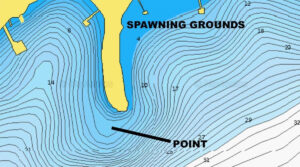
Throughout the spring and summer months, there’s often a lot of talk—and debate—revolving around targeting secondary and primary points. While Grigsby wholeheartedly believes points to be high-percentage targets, he doesn’t discriminate between the two types.
“Points give the bass quick and easy access to deep water,†Grigsby said. “And current washes current across the point, which serves as a virtual buffet for hungry post-spawners. But I focus more on points adjacent to spawning flats, which can be both secondary and primary points, so I don’t get too hung-up on their categorization.â€
When fishing these points, he suggests staying in deeper water while casting towards the shallower water found on top of the point. Because bass tend to move up and down on these points throughout the day, Grigsby believes this approach is an effective way to tell the most operative depth on a given day.
“Another cool way to figure out with depth range to target on points is to pay close attention to your electronics after you launch your boat,†Grigsby said. “I immediately turn on my Lowrance GenIII Touch unit and identify where the baitfish are. When you find them in a certain zone, that’s where you need to concentrate your efforts all day long. If you put your lipless crankbait in the same depth zone as the bait, you’ll catch ‘em.â€
Hotspot No. 3: Drains and ditches in flats
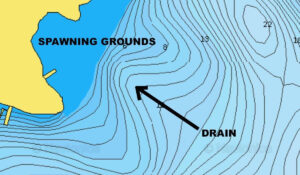
It doesn’t often take much to attract a bass and that’s certainly the key with this particular lipless hotspot. If you’re able to find a small drain—also referred to as a ditch—in some sort of shallow-water flat, there’s a great chance of finding a big concentration of bass.
“Man, these bass will get into some of the tiniest ditches and absolutely stack up,†Grigsby said. “They’re highways to and from shallow water, but they’re also emergency exits. We often forget that bass are big-time prey to birds such as eagles and ospreys, so when they see one of those dudes hovering over their heads, they’ll jump in these ditches and use ‘em as an escape route.â€
Hotspot No. 4: Riprap
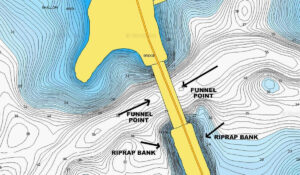
Riprap is often an overlooked sanctuary for late-spring and summer bass and immediately following the post-spawn period, these rock-filled banks are made even better by early morning shad spawns.
Furthermore, riprap banks are frequently found on bridges and causeways, which act as natural funnel points to and from deep water. In other words, if a bridge intersects a particular creek, bass have no choice but to pass through these areas when migrating. As you can guess, this can lead to incredible numbers of bass and excellent fishing action.
“You hear a lot of anglers talking about squarebill crankbaits on riprap,†Grigsby said. “But I actually really like lipless crankbaits in these areas, too. You do, however, have to be on top of your game to ensure you don’t get snagged. If you have to take a long time to switch hands before you engage your reel, your lure will be in the rocks before you even start your retrieve. The key is very similar to buzzbait fishing—you need to start your retrieve when that lipless is about 6 inches from landing in the water so you can get it going above the rocks from the get-go.â€
Hotspot No. 5: Grass lines
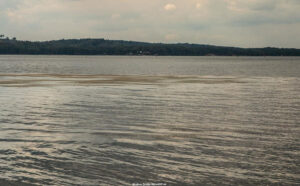
Just like Forrest Gump and Jenny, grass lines and lipless crankbaits go together like peas and carrots. Yes, it’s true—where there’s grass, you’ll probably find bass. But more importantly, there are two things that make these grass edges particularly attractive to warm weather bass.
“It’s tempting to get dialed-in on hard cover such as rocks, concrete and boat docks when we’re looking for a shad spawn,†Grigsby said. “But never overlook these grass lines because they can be absolutely rockin’ this time of year. Also, they serve as an all-important edge for bass as they travel throughout the day. Bass can be insecure little creatures, so they prefer to follow a natural edge as they move to and from deeper water.â€
To maximize his efficiency when fishing these lines, Grigsby makes a concerted effort to parallel the edges with his lipless crankbait. Perpendicular casts will only put your lure in the strike zone for a few turns of the reel handle, while parallel casts ensure your bait stays in “the zone†for as long as possible.
“Like we talked about earlier, this is when I’m going to tick the grass with my lure,†Grigsby said. “I’ll burn it across the tops of any irregular grass stalks and right as I feel it try to bury in that vegetation, I’ll quickly rip my rod tip upward to free the lure. This quick jerk is often when some of your best strikes occur.â€
When the bass fishing action starts to slow in your area this season, don’t get discouraged. Tie on a lipless crankbait, cover water and locate these hotspots—you’ll be surprised by how much fun it can be.












